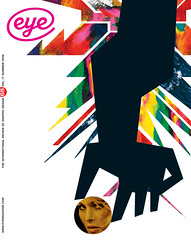Summer 2008
Vicente Tigre
Who cares about graphic design history?
Vicente Tigre, from Brazil, graduated from PUC-Rio (Pontifícia Universidade Católica do Rio de Janeiro) in 2006, after a year at Leeds University.
Q1. What do you think is meant by ‘the canon of graphic design history’? Do you buy design history publications? Principles forged in the history of graphic design?
A1. I don’t read design history publications, and I despise the idea of a canon.
Q2. Does this kind of design history have relevance to what you do in your design practice?
A2. Not in a conscious way. I don’t look for ‘historical design pieces’ as reference or inspiration, or work with the ‘golden rules’ of the past in mind. I was quite a ‘rebel’ against the rules of Constructivism and Modernism during most of my design education – I even chose the deconstruction of graphic ideas as the topic for my final diploma, believing I was being contemporary.
At this time that I found myself obliged to study more about design history – to find out what I was rebelling against. I then discovered that my rebellious behaviour towards the canons of mid-twentieth-century design was not exclusively mine, or of my generation. It had already happened almost fifteen years before!
Since then, I have accepted the influence of graphic design history on my everyday practice. It is part of visual culture and will always be.
Q3. Where did you learn about design history (if at all)?
A3. I had a few classes at my design academy. But I only really started learning about design history, by myself, when I felt the need to understand what I was doing.
Q4. Does history have any relevance to the new technology and techniques you’ve had to master in your work?
A4. Only for typography, in typesetting and the choice of types.
Q5. If you were in charge of a design education programme, what aspects of design history would you teach?
A5. I would focus on typography; trying to link the past and present. That could be a key to drag out the interest of students. History is not so popular in the academies, because teachers have difficulties linking it to current practice. Designers of my generation have this urge to be ‘edgy’ or ‘trendy’, and they believe that avoiding history is a way. They treat design history as a part of the past that stayed in the past.
If I were in charge of a design education programme, I would trace how design history, and the canon, is still alive (and kicking!) in graphic design – and how even the rebels can take advantage of it.
First published in Eye no. 68 vol. 17 2008
Eye is the world’s most beautiful and collectable graphic design journal, published quarterly for professional designers, students and anyone interested in critical, informed writing about graphic design and visual culture. It is available from all good design bookshops and online at the Eye shop, where you can buy subscriptions and single issues.

